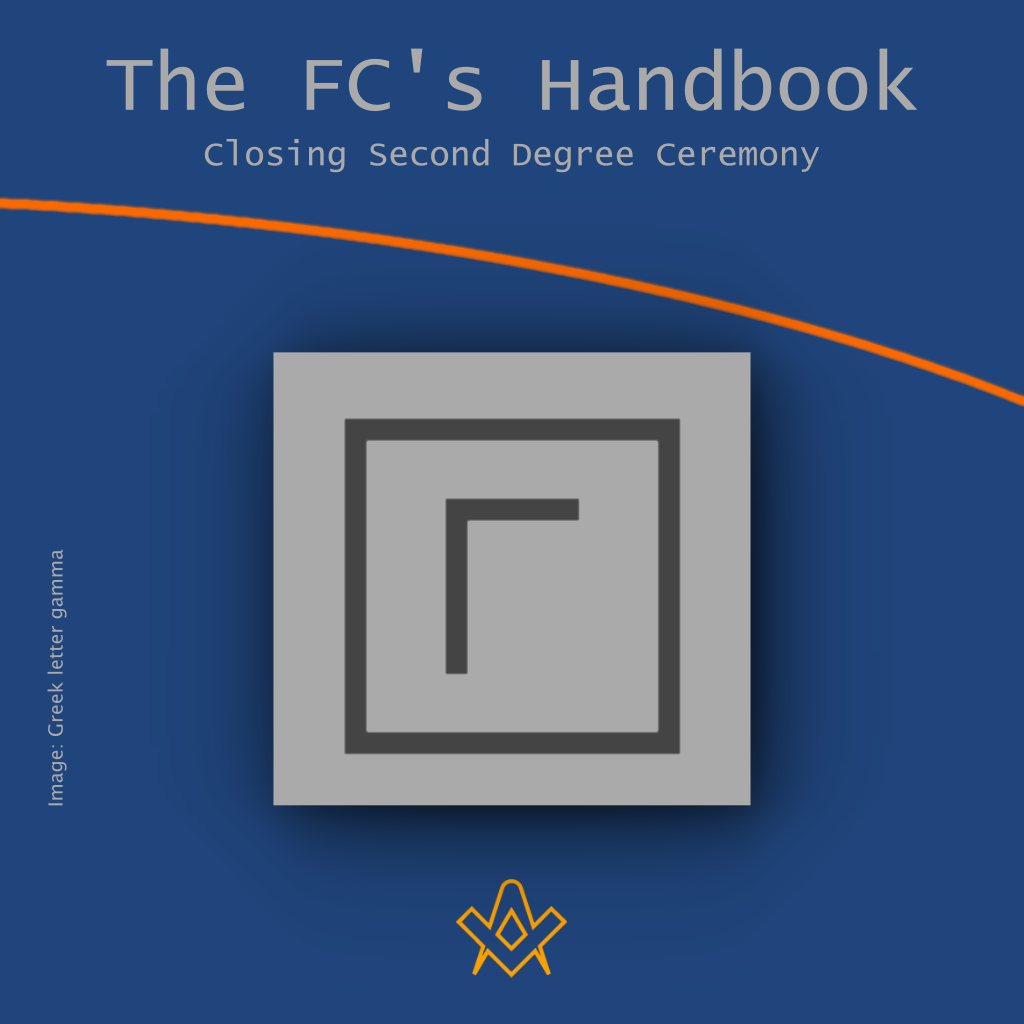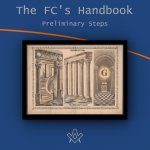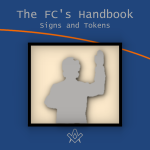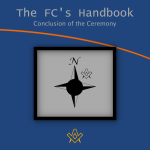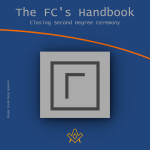[Editor Warning: This article contains reference to the Swastika with respect to its religious connection. If reference to this symbol causes offence, please close this article now and read no further.]
As in the first degree, the Spirit calls on the Body and Soul to show that they are on guard against this world.
CHAPTER 6
Closing Second Degree Ceremony
The Spirit then asks the body what it has discovered now that it has conformed to the laws of rectitude, as a true Fellowcraft, and the Body replies that it has discovered a Sacred Symbol.
This Sacred Symbol, of course, is that same letter ‘G’ mentioned in the tracing board, which corresponds with the Hebrew characters for the Name of God.
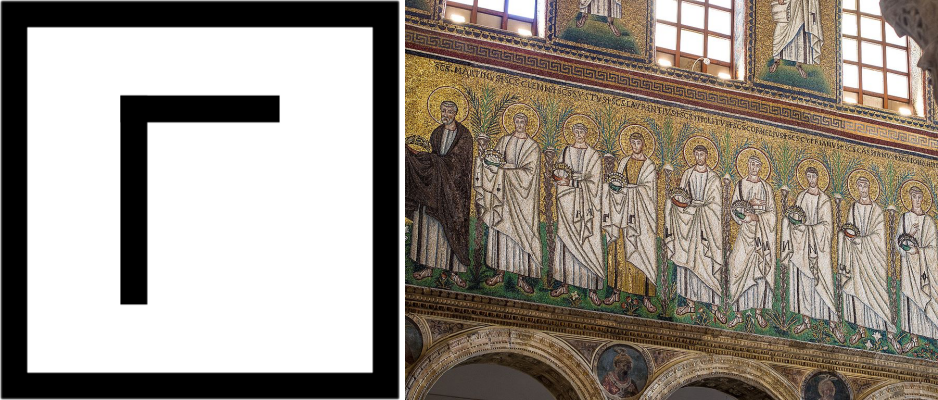
left: Greek letter gamma (Γ).
right: Basilica of Sant’Apollinare Nuovo
IMAGE LINKED: wikimedia Attribution 4.0 International (CC BY 4.0)
As we have already explained the full significance of these four letters we will not now discuss them further, but a few brief lines dealing with the valuable suggestion of Sir John Cockburn, that the letter ‘G’ was originally depicted in the mediaeval lodge by a square, calls for some consideration.
Sir John has pointed out on many occasions that the square, more particularly the gallows square, was always regarded with very great veneration by the Masons, because not only was it an important working tool, with a symbolical meaning attached to it, but it was also the shape of the gamma, or ‘G’, in the Greek alphabet, as well as in the ecclesiastical script used in mediaeval Europe.

This is a ‘Gammadion Cross’. Since the church was consecrated in 1891, the symbolism was not inspired by Nazism.
IMAGE LINKED: wikimedia Attribution 4.0 International (CC BY 4.0)
Thus the letter ‘G’ and the gallows square were the same shape, and stood alike for God and His great characteristic, ‘Justice’.
Indeed, in mediaeval paintings the square is often found embroidered on the vestments of the disciples, and when depicted separately these are called ‘gammadias’, that is ‘gammas’, but when combined to form the Swastika it is called the ‘gammadion’.
As Sir John points out, references to this identification of the square and the ‘G’ are found in several old rituals.
Additional Content:
The swastika symbol, 卐 or 卍, is an ancient religious symbol in various Eurasian cultures, now also widely recognized for its appropriation by the Nazi Party and by neo-Nazis.
It continues to be used as a symbol of divinity and spirituality in Indic religions, including Hinduism, Buddhism and Jainism.
It generally takes the form of a cross, the arms of which are of equal length and perpendicular to the adjacent arms, each bent midway at a right angle.
In the Western world, it was a symbol of auspiciousness and good luck until the 1930s when the German Nazi Party adopted a right-facing (‘clockwise’) form and used it as an emblem of the Aryan race. As a result of World War II and the Holocaust, in the West it continues to be strongly associated with Nazism, antisemitism, white supremacism, or simply evil.
As a consequence, its use in some countries, including Germany, is prohibited by law. However, the swastika remains a symbol of good luck and prosperity in Hindu, Buddhist and Jain countries such as Nepal, India, Mongolia, Sri Lanka, China and Japan. It is also commonly used in Hindu marriage ceremonies and Diwali celebrations.
For example:-
Q. –Why did you get to be made an Fellowcraft?
A. – On account of the letter ‘G’.
Also an old Masonic legend found in one of these rituals, describing a murderous assault made on one of the chief overseers of the work by some of the workman, relates that one of the wretches struck the overseer a blow over the heart with a square.
When the victim was subsequently discovered, those who found him noticed a faint trace of the letter ‘G’ on his breast, and they understood it as symbolising the whole-hearted devotion which the victim had always displayed towards God, the G.G.O.T.U.
Another interesting point about the square is that if four right angles are joined together with the angles inward, an equal-armed cross, or cross of the cardinal points, is formed.
This cross, of course, has many inner meanings, but one at least is that it represents the earth and matter, just as does the four-sided square, which also can be formed out of four gallows squares.
Finally, the Swastika which later symbolised the sun, is also composed of four right angles; hence the vital fluid permeating matter makes of it a living soul.
In this last aspect the Swastika becomes an emblem for God Himself, and thus the square in itself represents not only God but also the universe, which He preserves by His Divine Spirit.
So it will be seen that the Sacred Symbol, which the Fellowcraft’s declare that they have discovered, is of far greater significance than most brethren would suspect; in fact, in these few brief words of the closing ceremony we obtain a summary of the whole purpose of the degree, and realise why, throughout the whole of it, the square is emphasised.
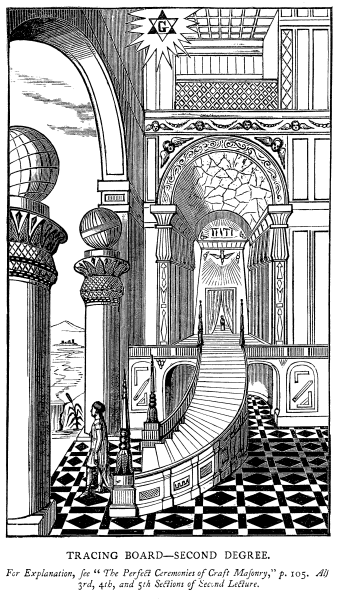
second degree tracing board
IMAGE LINKED: wikimedia Attribution 4.0 International (CC BY 4.0)
Nor must we forget that when he announces this discovery the J.W. stands in the correct position to indicate that he represents that fifth letter, the missing ‘sh’, which changes the name of the Creator into that of the Preserver-Yeheshue.
Moreover, he declares the Sacred Symbol is situated in the Centre of the building. Bearing in mind that in the tracing board we were told that our ancient brethren discovered this symbol in the Middle Chamber, we shall perceive that the Lodge itself is now the Chamber, into which the candidate has ascended by the Winding Staircase of the five Steps which led him to the East.

lodge room
IMAGE LINKED: wikimedia Attribution 4.0 International (CC BY 4.0)
The fact that it is in the Centre reminds us of that hidden centre in every man, where resides the Divine Spark, and brings to our recollection the statement in the first tracing board that there is a point within a circle around which the brethren. cannot err.
In lodge in the Provinces which have their own Temples, it is usual to see depicted on the roof a pentacle, in the middle of which can be seen the letter ‘G’.
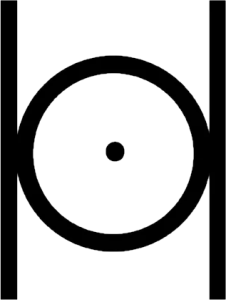
In this case the pentacle represents man with his five senses, with the ‘G’ at the centre to remind us of the Divine Spark within.
On the floor directly underneath is inlaid in brass a point within a circle, which circle is bounded on the north and south side by two grand parallel lines, usually described as the two St Johns, but stated in our ritual to represent Moses and King Solomon.
They also undoubtedly symbolize many other things, e.g., the two pillars of night and day, good and evil, male and female, etc.
The point I wish to stress, however, is that the brass point at the centre of the circle is directly underneath the ‘G’ in the pentacle on the roof, thus emphasising the interpretation we have been studying.
It is a thousand pities that in most of our London Lodges both these essential ornaments of the Lodge are omitted from the decorations, as by so doing their intimate connection is apt to be overlooked by the brethren, and even the words of the ritual become untrue.
Thus the Fellowcraft degree teaches us that we only begin to recognize the God within us when we have lived a good life.
There is also, probably, a reference to the word ‘Generation’, which is naturally associated with the life of the fully developed man.
The meaning of this is that the power of begetting is a Godlike gift, for it creates physical life, and we must use it with respect and for the noblest ends.
It is only when we are masters of our passions in this respect that we are fitted for the last and greatest trial.
It is noteworthy that it is the J.W., representing the Body, who plays the most important part in the closing of this degree, which is, of course, appropriate, as we have been dealing throughout with the body and its five senses.
This phase is carried through to the very end, as is shown in the curious doggerel lines with which the J.W. performs the last act of closing.
As given in Emulation they are only three, but in the Provinces they are four, and form a curious jingling rhyme, which runs as follows:-
![]()
happy have we met
happy have we been
happy may we part
and happy meet again
Personally I prefer this four line version to that in Emulation which, for some unaccountable reason, omits the second line, although it is quite as important as the first or third.
Clearly the brethren might be happy to part because they had been unhappy during the ceremony!
The inner significance of the lines, however, is that the body bears testimony that earthly happiness can only be found by those who know God.
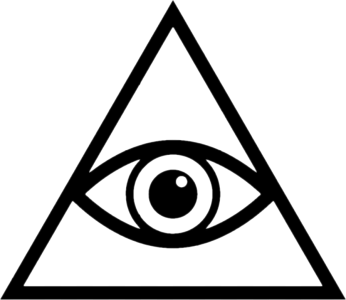
The closing prayer by the W.M. contains one important reference, which seems to be an ancient landmark carried down in our ritual from a long distant past, viz., the All-seeing Eye.
This Sacred Eye was a divine emblem and an important talisman among the ancient Egyptians, even as it still is among the Chinese, who paint it on the bows of their ships to protect them and preserve them from misfortune.

The ancient Egyptian wedjat – Eye of Horus – symbolising healing and protection. Image: Jeff Dahl – Own work
It is essentially an emblem of God the Preserver, and its inclusion in the closing prayer of the second degree indicates how carefully the preservative aspect of God is stressed, from the beginning to the very end of the ceremony.
This concludes all that it is possible to deal with in this little book concerning the second degree, but those whose interest has been aroused will be well advised to do two things ; firstly to study the ritual itself, in order to discover additional inner meanings, which do exist, although they have not been dealt with here lest we should befog our newly passed brethren.; and secondly, study the lectures on this degree, which contain a great deal of interesting information, much of it with an inner meaning seldom appreciated by those who have only read them through hastily.
Finally we would add that in the Master Mason’s Handbook will be found an explanation of several points which we have had to omit in this book, but which show how carefully each of our degrees is linked up with the one that follows, and how to the attentive student they gradually unfold many important and illuminating truths.
This concludes The Fellowcraft’s Handbook. Next month we examine The Master Mason’s Handbook, also by JSM Ward.
Article by: J. S. M. Ward
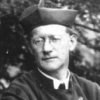
John Sebastian Marlow Ward (22 December 1885 – 1949) was an English author who published widely on the subject of Freemasonry and esotericism.
He was born in what is now Belize. In 1908 he graduated from the University of Cambridge with honours in history, following in the footsteps of his father, Herbert Ward who had also studied in history before entering the priesthood in the Anglican Church, as his father had done before him.
John Ward became a prolific and sometimes controversial writer on a wide variety of topics. He made contributions to the history of Freemasonry and other secret societies.
He was also a psychic medium or spiritualist, a prominent churchman and is still seen by some as a mystic and modern-day prophet.
Recent Articles: The Fellowcraft's Handbook
masonic knowledge
to be a better citizen of the world
share the square with two brothers

click image to open email app on mobile device



